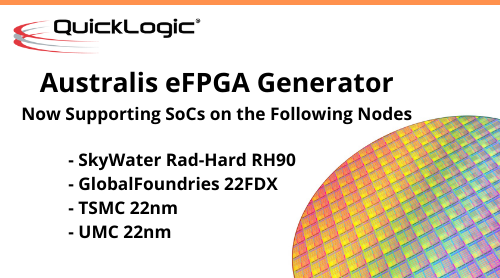The Benefits of eFPGA Technology
Hopefully by now it is becoming obvious that embedding FPGA IP into SoC designs can provide tremendous benefits to the company building the SoC. Adding a customized programmable fabric gives developers a level of post-manufacturing flexibility they could only have dreamed about in an earlier time. Just a few of the benefits engendered by this flexibility include the ability to modify the functionality of the SoC to add new features, support emerging standards, meet new competitive challenges, or address multiple adjacent market opportunities with a single device. Another benefit is that it enables companies to better manage their supply chain since the SoC can also be repurposed to support other applications.
We call that collection of benefits “mass customization” as it allows a single mass market device produced in high quantities to be customized for a variety of purposes. That approach extends the market potential and market life for the device, with the potential to dramatically increase its overall profitability and ROI. This is particularly important as the SoC itself may have a relatively long and expensive development cycle.
The Challenge of Implementing the Technology
The challenge that we faced, though, was how to support implementing eFPGA technology for multiple customers given the large number of foundries and process nodes available to SoC developers. If only there were a tool that could make targeting a particular foundry and process node fast and easy for everyone who needed it…
That’s Why We Created Australis
When we announced the Australis eFPGA IP Generator back in September of last year, we knew we had something special. Built upon the OpenFPGA open-source framework, the Australis tool was the result of QuickLogic’s three decades of expertise in designing and manufacturing area- and power-efficient programmable logic architectures and devices.
One of the great attributes of the Australis tool is that it allows SoC developers to quickly and easily target their embedded FPGA fabric for nearly any foundry and process node available.
At the time of the announcement, we made the somewhat outlandish claim that this tool would reduce the time needed to implement customized embedded FPGA IP from months or quarters to as little as a few days. In fact, to quote our press release, we listed as a customer benefit “Fast time-to-market – Customized eFPGA IP – from description to GDSII format in days.” Sounds a little crazy, right?
Australis Delivers
Fast forward to today. Since we introduced Australis a scant eight months ago, multiple customers have indeed implemented QuickLogic embedded FPGA designs targeting a number of foundries and process nodes, including most of the leading fabs in the world today. We have announced several of these in press releases over the last few quarters; they include:
- September 1, 2021: Announced $2M eFPGA Contract
- October 26, 2021: UMC 22nm process
- March 8, 2022: SkyWater Rad-Hard RH90 process
- March 10, 2022: New ~$1M eFPGA Contract
- March 14, 2022: TSMC 22nm process
- March 30, 2022: New $1.5 Million eFPGA Contract
- April 14th, 2022: GlobalFoundries 22FDX process
So, you can see that maybe our claims weren’t so crazy after all. If you are interested in joining this wave of SoC developers who’ve embraced eFPGA technology and the Australis eFPGA IP generator, just visit www.quicklogic.com/products/efpga/efpga-ip2/

